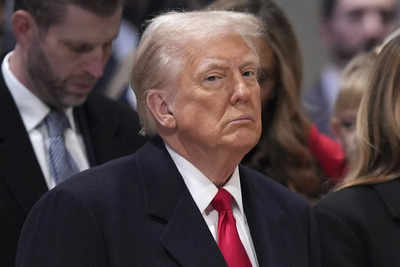Latest Education news – Board Exam Results, Admit Cards, Exam Paper Analysis and Question Papers | Times of India
The Trump administration has ripped up decade-old restrictions, giving Immigration and Customs Enforcement (ICE) and Customs and Border Protection (CBP) the green light to arrest illegal migrants in so-called ‘sensitive locations’— including schools and churches.
For over a decade, immigration officers were barred from making arrests in these areas to avoid disrupting communities and causing public outrage. But in a bombshell move, the Department of Homeland Security (DHS), which oversees both ICE and CBP, announced the rollback on January 21, Trump’s second day in office, justifying it as a necessary measure to enforce immigration laws and crack down on criminal activity.
“This action empowers the brave men and women in CBP and ICE to enforce our immigration laws and catch criminal aliens — including murderers and rapists — who have illegally come into our country,” a DHS spokesperson declared in a fiery statement.
The statement didn’t mince words, accusing undocumented migrants of exploiting schools and churches as sanctuaries to avoid arrest. “Criminals will no longer be able to hide in America’s schools and churches to evade capture,” the spokesperson added.
As this controversial policy takes effect, schools and churches across the country brace for the fallout, with the Trump administration doubling down on its commitment to what it calls “uncompromising immigration enforcement.”
Explained: US Sensitive Locations Guidance and its implication for schools
The Sensitive Locations Guidance, introduced in 2011 by then-ICE Director John Morton under the Obama administration, provided a shield for America’s schools, churches, hospitals, and other vital public spaces from immigration enforcement. Crafted to protect vulnerable communities, it prohibited actions such as arrests, searches, and surveillance in these areas to ensure that essential services and spaces of refuge remained free from fear and disruption.
In 2013, the Obama administration expanded the guidance to cover US CBP, ensuring its application across all immigration enforcement agencies. The additions reinforced the federal government’s commitment to protecting spaces vital to public welfare, with schools designated as a primary focus of the policy.
Schools as Protected Spaces
Under the guidance, schools were considered sacrosanct. The policy extended protections to:
- Educational Institutions-Including primary, secondary, and post-secondary schools.
- School Bus Stops-Protected during active pick-up and drop-off hours.
- Children’s Recreational Areas-Playgrounds and community centers.
The intent was clear: Allowing children to attend school without the shadow of immigration enforcement looming over them and to ensure that families could fully engage with educational institutions.
What the Guidelines Prohibited
The policy explicitly barred enforcement actions at or near sensitive locations except under narrow circumstances, such as:
- Threats to National Security-When immediate action was required.
- Imminent Risks of Violence-To address urgent public safety concerns.
- No Viable Alternatives-When an arrest could not reasonably be carried out elsewhere.
Officers needed prior approval from supervisors for any enforcement activity in these areas, ensuring strict oversight.
#Illegal #immigrants #arrested #schools #Trump #administration #blows #protection #lid #sensitive #zones #Times #India
